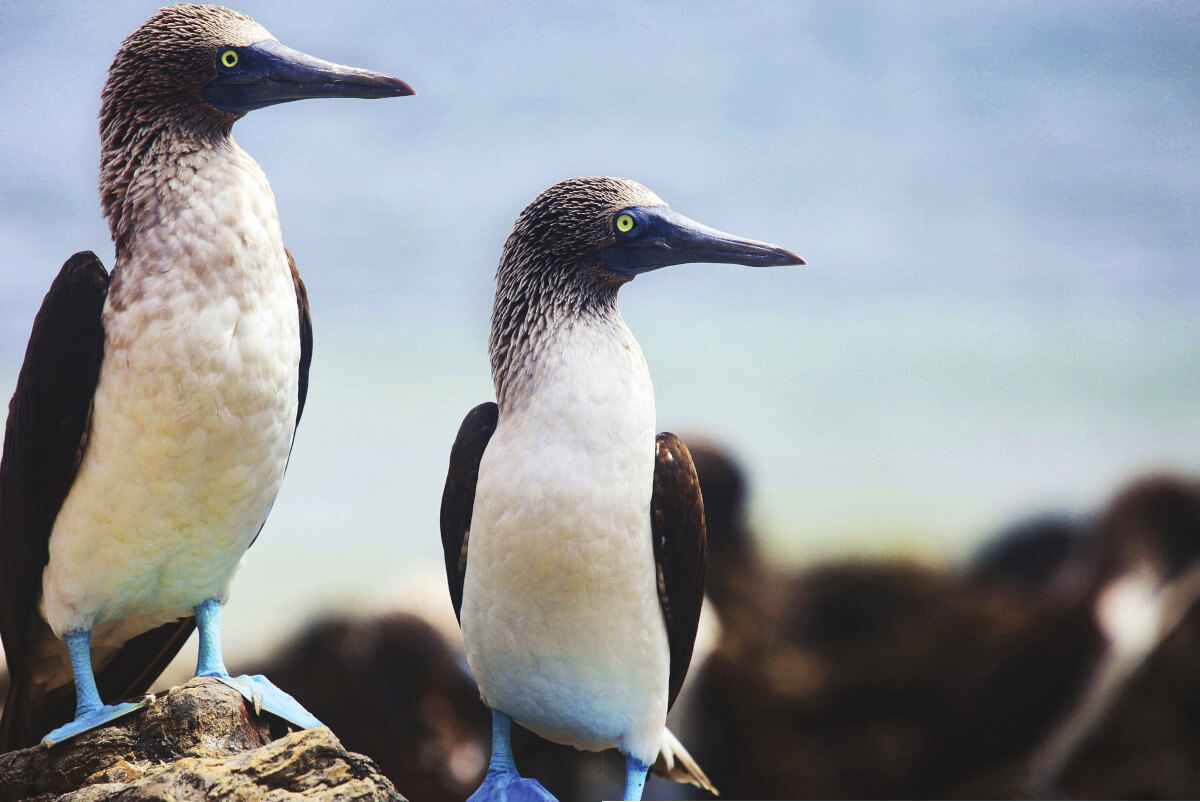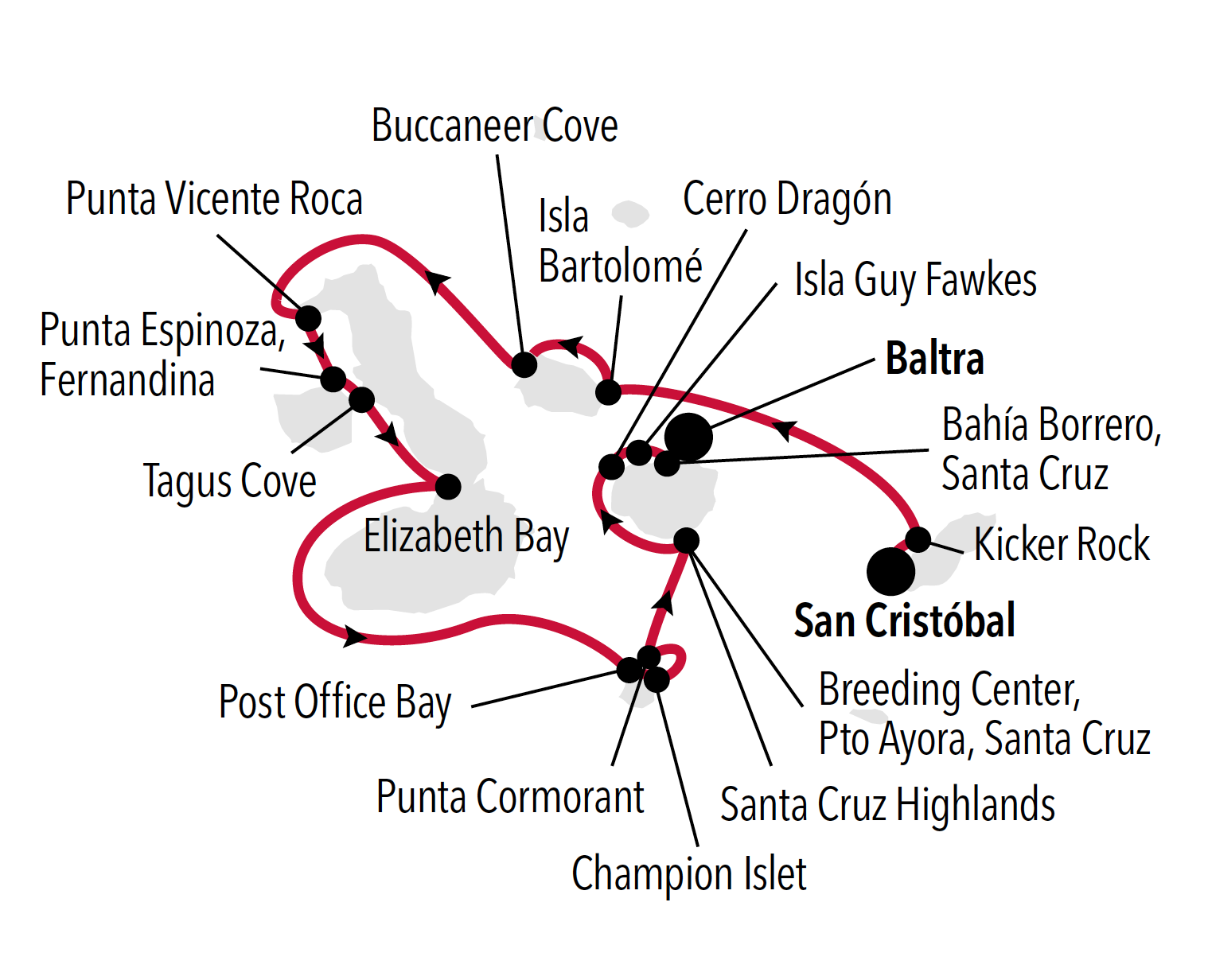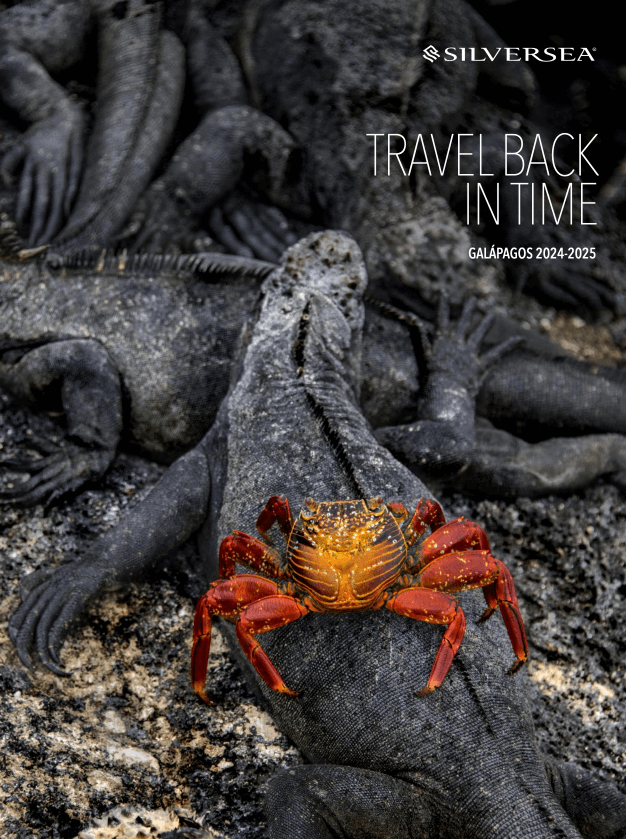This 8-day luxury Western Galapagos expedition cruise sailing from San Cristobal to Baltra aboard the 100-passenger Silver Origin.
There is a reason why we keep returning to the Galapagos Islands. They offer so much to the interested traveler; a biological wonderland that is visually stunning and educationally fascinating, the Galapagos is where time has stood still. From giant tortoises to lava tunnels, tidal pools to mangrove forests, take the journey of a lifetime and truly discover the distant islands that Darwin made famous.
See the western Galapagos in all its technicolor brilliance, from Blue-footed Boobies and black lava shores to fragrant incense trees and Spotted Eagle Rays. You’ll also explore one of the most volcanically active places on Earth.
Silversea Expeditions is committed to making your time with them in the Galápagos unforgettable. Big on creature comforts and luxuries, our intimate all-suite Silver Origin feels personal and convivial. Accommodating just 100 guests, Silver Origin has been designed especially with the bio-diversity of the Galápagos Islands in mind.
New, improved itineraries offer a vast range of island wildlife, including many endemic species. What’s more, their team of enthusiastic and dedicated experts will guide you every step of the way. If the question is immersive travel destination, the answer has to be The Galapagos.
About Galapagos – Western Itinerary
8 days / 7 nights —
San Cristobal to Baltra
From: $10,260
Request an eBrochure
Book Now
Contact Sunstone Tours & Cruises1-888-815-5428 Toll-Free
- Day 1: San Cristóbal & Kicker Rock
-
Like so many of the islands in the Galapagos, San Cristobal is formed by dormant volcanoes. It lies to the east of the archipelago and is one of the oldest islands in the group. Approximately 8,000 people live on the island, making their living from tourism, fishing, in government offices, or off the rich volcanic soils with some limited farming existing in the highlands. Puerto Baquerizo Moreno on the southwestern tip of the island is the capital city of the Galapagos Islands. A statue of Charles Darwin graces the harbor, marking one of the first places he likely stepped ashore in the 1830s.
Kicker Rock is the vertical remnant of a former tuff cone less than 5 kilometers to the west of San Cristobal. Both its Spanish name “Leon Dormido” (Sleeping Lion) and English name Kicker Rock imply that it is one rock only -when in fact it is a larger one 300 meters long by 100 meters wide with a maximum height of approximately 150 meters and next to it an obelisk-like rock separated by a narrow channel some 20 meters deep. When approaching Kicker Rock, Blue-footed Boobies, Nazca Boobies and frigatebirds can be observed in the air, while sea lions can be seen along the shore. Snorkelers and divers have reported manta rays, hammerhead sharks and turtles. The Spanish name implies that the geological formation seen from the south resembles a sleeping lion. An interesting explanation for the English name suggests that James Colnett in 1794 likened it to famous landmarks in Portsmouth.
- Day 2: Isla Bartolome & Buccaneer Cove, Santiago
-
The Silver Origin anchors in sight of the volcanic moonscape of Isla Bartolomé, at Sullivan Bay. Zodiacs bring guests ashore to ascend a boardwalk of 388 steps. Passing through the arid volcanic landscape provides a chance to watch for lava lizards, Galapagos Hawks, and Blue-footed Boobies. However, the climber’s ultimate reward is one of the most beautiful panoramas in all of the Galapagos Islands – the view towards Pinnacle Rock with black, volcanic cones of Baltra, Daphne Major and Daphne Minor in the distance. On the way down watch how the sunlight catches the green of pioneering plant species in stark contrast against dark volcanic rock, and look forward to time swimming and snorkeling from the golden beach.
Buccaneer Cove is a colourful inlet on Santiago or James Island. It owes its name to some of the first visitors to the area: pirates. They came searching for water, tortoises, and some people say even places to hide their treasures. We don’t know about any pirate’s gold, but the area’s landscape is a treasure. The geology combines some tuff red cones with impressive basalt lava dikes and sills. The erosion has carved caves and shaped some rocks into unique forms such as the Bishop’s Rock. Palo Santo trees and some giant Prickly pear cactus cover the area, and at a distance, you can observe the impressive volcanos of Isabela Island. We will explore the area from our Zodiacs, searching for sea birds such as Nazca Boobies, Blue Footed Boobies, and Swallow-tailed Gulls. We can often find sea turtles and even reef sharks in this place. Also, in Buccaneer Cove, we can observe the two sea lions species: the Galapagos sea lion basking on the beaches and the fur seal looking for shade on the collapsed rocks along the coast.
- Day 3: Punta Vicente Roca (Isabela) & Punta Espinoza, Fernandina
-
Punta Vicente Roca is one of the marine sites Isabela Island has to offer. On the southern side of Ecuador Volcano, the tip of land on the western end of Isabela is named after Vicente Ramon Roca, President of Ecuador from 1845-49, who as Prefect of Guayas had proposed the Ecuadorian annexation of the Galapagos Islands in 1831. The geological formations, the underwater caves and lava tubes offer fascinating views of the coastline. The South Equatorial Countercurrent hits this part of the archipelago from the west and the water offers abundant food sources for different marine life and seabirds. It is normal to see Pacific green turtles, but sharks, rays, whales and dolphins can also be expected, apart from a small colony of fur seals. Blue-footed Boobies, Nazca Boobies, Brown Noddies and other seabirds nest in the cliffs and both the endemic Galapagos Penguins and Flightless Cormorants have established small colonies nearby. Marine iguanas also like this area because of the rich variety of seaweeds growing underwater along the western coast of Isabela. As a marine site, deepwater snorkeling is also possible at Punta Vicente Roca.
With the gentle slopes of La Cumbre volcano in the distance, the low, lava-forged coast of Punta Espinoza on Fernandina Island is a spectacular sight. Hundreds of marine iguanas rest on the black rock of recent lava flows absorbing heat from the stone and defending their territories against one another. Galapagos sea lions and their pups also take shelter here, resting on the beach and playing in the shallow tide pools sprinkled along the coast. Walk past high sandy areas where marine iguanas lay their eggs and along low, shallow mangrove ponds ringed with bright red Sally Lightfoot crabs and Flightless Cormorants drying their stubby wings in the sunshine.
- Day 4: Tagus Cove & Elizabeth Bay (Isabela)
-
Tagus Cove is bordered by a steep rocky coastline and has for centuries offered shelter for ships and yachts. The cove is named after the British frigate HMS Tagus visiting the Galapagos in 1814. Already by the 1830s other ships had their visits recorded by painting or scratching their nameonto the rocks. On approach Galapagos Penguins and Flightless Cormorants –both birds mainly found on Isabela’s west coast and neighboring Fernandina- are often seen. From the landing a trail through an incense tree forest leads past Darwin Lake to a viewpoint on top of a spatter cone. During the hike several land birds including Medium Ground-Finches, Galapagos Hawks, Yellow Warblers as well as Large-billed Flycatchers are often present. Brown Noddies and Blue-footed Boobies prefer the rocks along the shore.
Elizabeth Bay is one of the marine sites on Isabela’s west coast. South of Alcedo Volcano and north of Sierra Negra, Elizabeth Bay is found at Isabela’s narrowest east-west extension where the lava flows of these two volcanoes have connected each other. Elizabeth Bay’s shores show mangroves and specifically the easternmost part, a cove which can only be entered via a narrow channel, has red, white and black mangroves. Different animals prefer different parts of Elizabeth Bay. Las Marielas, three rocks at the entrance to the bay, are favored by Blue-footed Boobies, Flightless Cormorants and Galapagos Penguins as a resting place, while the mangrove area is preferred by Great Blue Herons for hunting or the Magnificent Frigatebirds for perching. The bay is used by turtles, rays and even sharks for feeding or resting. The shallow water and the root system of the mangroves in the small inlet allow smaller fish to hide from bigger predators.
- Day 5: Post Office Bay, Champion Islet & Punta Cormorant (Floreana)
-
Floreana’s Post Office Bay has received its name as the site was used to leave mail for retrieval by others who were thought to stop at the Galapagos Islands or might be heading for the addressee’s direction. First mentioned by Porter in 1813 as “Hathaway’s Postoffice”, HMS Beagle’s captain FitzRoy stated that it was not in use in 1835 as the island was already settled at that time. Floreana had been the first island to be settled by Ecuadorians in 1832. Today a barrel instead of the original box is used by visitors who leave their own postcards and retrieve mail for hand-delivery. Apart from the beach and mail barrel the bay offers good swimming and snorkeling. The area holds remains of a failed Norwegian fish canning plant and settlement dating back to the 1920s. Although Floreana is inhabited, the number of residents is reduced because of the difficult access to water. A track from Post Office Bay connects with the only road from Puerto Velazco Ibarra on the west coast to a spring in the highlands.
Champion Islet is a small islet some 700 meters off the northeast coast of Floreana. It is one of four marine sites surrounding Floreana and offers excellent deepwater snorkeling opportunities. Curious sea lions approach the snorkelers while turtles slowly swim by and sharks, sting rays, and a high diversity of colorful fishes can usually be seen. During a Zodiac cruise around Champion Islet not only seabirds such as Nazca Boobies, Swallow-tailed Gulls, or Red-billed Tropicbirds will be seen, it is also possible to spot the rare Floreana Mockingbird.
Floreana Island’s northernmost point is called Punta Cormorant – named after the British naval vessel HMS Cormorant and dating back to the late 19th century. From the landing beach a short track leads to a shallow lagoon that is famous for its flamingos. The brilliantly pink birds skim the salty waters for shrimp and tend to chicks on the nest. The trail then scales a low hillside through scattered Palo Santo trees to reveal an idyllic white-sand beach on the other side of the point. Standing at the edge of the lapping waves, you might spot mammoth female sea turtles hauling themselves out of the sea to lay eggs in the sugar sand dunes that lay high above the tide line. Before returning to the landing site your guides may also point out White-cheeked Pintails, Blue-footed Boobies, Yellow Warblers, and Medium and Small Ground Finches.
- Day 6: Santa Cruz Highlands & Fausto Llerena Breeding Center, Puerto Ayora (Santa Cruz)
-
Santa Cruz Island reaches a maximum altitude of 864 meters (2,835 ft) above sea level; at high altitudes, weather changes creating microclimates. The species of flora and fauna found near the shoreline are extremely different from those on the highlands. Life in the highlands is much easier due to the presence of fresh water, from the constant drizzle that happens during the dry season to heavy rains that occur during the wet season. Local people take advantage of this climate to cultivate a large number of crops and giant tortoises love this ideal weather to mate, feed and rest before their next long migration to the shorelines.
Silver Origin will anchor in front of Puerto Ayora, Santa Cruz, where the prestigious Charles Darwin Research Station is located. The station also houses the Fausto Llerena Breeding Center for giant tortoises and land iguanas where guides interpret the centre’s captive breeding and reintroduction programs. In addition to these star species, throughout the station there are huge prickly pear cactus trees being fed upon by the pretty Galapagos Cactus Finch. To round out the stay in Puerto Ayora, enjoy free time in town where local artists have created charming art galleries and corner cafés.
- Day 7: Cerro Dragon (Santa Cruz), Isla Guy Fawkes & Bahía Borrero, Santa Cruz
-
A dry landing onto volcanic rock covered by Sally light-footed crabs will welcome you as you disembark for this walk discovering Cerro Dragon. Enjoy this visit that mixes a brackish water lagoon inhabited by shorebirds, some elusive pink flamingos and a volcanic rock cover dry enough to be the perfect ecosystem for the Galapagos land iguana. Search for this iconic Galapagos inhabitant that populates this area of Santa Cruz. Your guide will be on the lookout too, helping you to recognise them whether they are resting in their burrows or next to the cacti looking for food.
Guy Fawkes is a group of four islets situated on the northwestern side of Santa Cruz Island. They are satellite cones, surrounded by deep waters. As they rise from the deep, they intercept with the strong sea currents making the area a place full of life. These small islets have beautiful underwater cliffs covered with all sorts of marine invertebrates such as sponges, corals, sea stars, urchins — making it a very colourful place for deep water snorkelling. Due to the conditions mentioned above, it results in some immense aggregations of fish, and, due to the depth of the water, it is not unusual to find Sharks or Manta Rays. Guy Fawkes is one of the most exciting places to deep water snorkel. You never know what you will find.
In the northern area of Santa Cruz Island, Bahía Borrero is a beautiful white coralline beach used as a nesting site by Green Sea turtles. Behind the dunes, we have a forest of typical vegetation from the arid zone: Palo Santo, Leather leaf, and Salty bushes. This vegetation welcomes Yellow Warblers, and some of the most characteristic species of Darwin Finches, such as the Common Cactus Finch or the Small Ground Finch. This extinct volcano, due to its altitude, shows all the different zones of vegetation, changing from the littoral to the arid, and then with more moisture into the humid zone, to end in the dry pampa zone. It is an impressive landscape to enjoy while you swim in the turquoise waters of the bay or have a nice relaxing walk along the beach.
- Day 8: Baltra
-
Baltra Island, also known as South Seymour, is truly the entrance to the Galapagos Islands. Despite not being considered as part of the National Park proper, Baltra definitely offers a taste of the weird and wonderful nature that thrives on the islands. The island is located in the central part of the archipelago. At just eight sq. mi it is one of smallest islands, yet its flat, volcanic rock surface and central location in the archipelago makes it an ideal place for one of the islands’ two airports. The airport was built by the US Air Force, who used it as an army base during WWII. As a travel destination in itself it offers few attractions, and all travellers who come here are just passing through, either on either way to or from the islands. There is no tourism infrastructure (save a few agencies that offer tours of the islands) or shops on Baltra and any purchases that you might wish to make should be done at the airport if they can. However, land iguanas and Galapagos finches are popular sights, and the iguanas are often seen running across the runway itself. You will be amazed how playful sea lions and some sea birds welcomed you at the pier.
 small ship adventure cruises®
small ship adventure cruises®


